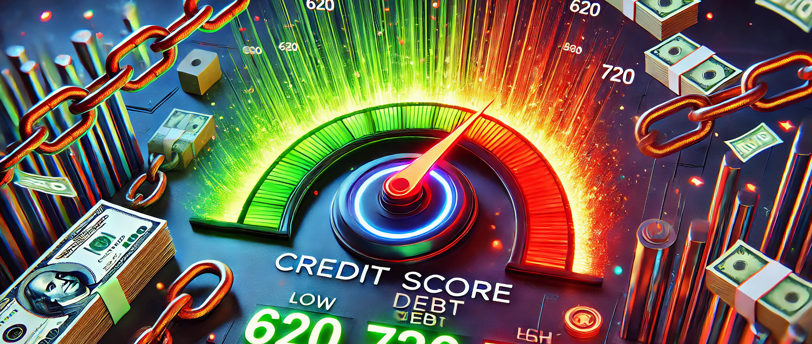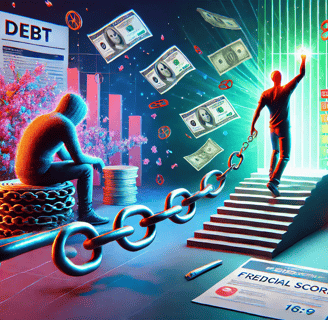The Direct Route (TDR): The No-BS Strategy to Crush Your Debt and Skyrocket Your Credit Score
Learn how The Direct Route (TDR) strategy can transform your finances by focusing on paying bills on time, attacking credit, and eliminating debt. Discover actionable steps to boost your credit score and secure your financial future.
8/26/20244 min read


The Direct Route (TDR)
In today’s world of financial advice, where everyone’s telling you to save every dollar, we’re here to flip the script. It’s time to rethink your strategy and start attacking your credit head-on. Welcome to The Direct Route (TDR), a bold approach that focuses on boosting your credit score, crushing your debt, and setting yourself up for long-term success.
This isn’t about playing it safe—it’s about being aggressive. TDR is designed to help you take control of your finances by paying bills on time, getting more credit, and eliminating bad debt. If you’re ready to leave behind the old-school ways of thinking and get on the fast track to financial freedom, you’re in the right place.
Let’s dive in.
The 80/20 Rule: The Foundation of TDR
At the core of TDR is the 80/20 rule. Here’s how it works: Allocate 80% of your active income to paying your bills and expenses on time, while the remaining 20% goes toward paying off bad debt.
Why is this so powerful? Because it shifts your focus from just saving to actively improving your financial health. On-time payments strengthen your credit, while the 20% allocated to bad debt chips away at those negative marks. This balanced approach ensures you stay on top of your current obligations while improving your future financial prospects.
Bill Management: The First Phase
The first step in TDR is all about mastering your bills. Paying bills on time might sound basic, but the impact is enormous. Late payments can drag down your credit score and lead to a snowball of financial problems. On-time payments, however, are your ticket to building credibility and improving your financial standing.
Here’s how to make it happen:
Automate Payments: Set up automatic payments for all your bills.
Prioritize Your Expenses: Essentials like rent, utilities, and minimum credit card payments come first.
Stay on Track: Use reminders and financial apps to keep everything in order.
By nailing this phase, you create a strong financial foundation that supports the rest of the TDR strategy.
Attacking Your Credit: The Aggressive Approach
Once your bills are under control, it’s time to go on the offensive—against your credit. While most people think getting more credit is risky, TDR takes the opposite stance. By responsibly acquiring more credit, you can lower your credit utilization ratio, which boosts your credit score.
But here’s the key: responsibility. This isn’t about spending recklessly; it’s about using credit as a tool for financial growth.
How to do it:
Apply for New Credit Cards: Start with one or two cards that offer favorable terms.
Manage Existing Debt: Keep paying off bad debt with that 20% allocation. The combination of more credit and less debt works wonders for your credit score.
This phase is about using credit to your advantage—not letting it control you.
The Payoff: Watching Your Credit Score Soar
With your bills under control and your credit under attack, your credit score will start to climb. The TDR strategy is designed to create a ripple effect: on-time payments and reduced debt lead to a better credit score.
Why does this matter? A higher credit score opens up a world of financial opportunities—lower interest rates, better mortgage options, and higher credit limits. The long-term benefits of TDR give you more financial flexibility and security.
A Case Study
Let’s put this into perspective with a real-life example. Meet John, a 30-year-old with a credit score stuck at 620. He’s been struggling with late payments and bad debt, feeling stuck in a financial rut. That’s when he decided to implement TDR.
Before TDR:
Credit Score: 620
Late Payments: 4 in the last year
Bad Debt: $5,000
Savings: $3,000
After 12 Months of TDR:
Credit Score: 720
Late Payments: 0
Bad Debt: $1,000
Savings: Still $3,000 (but with a better credit score and no late payments)
By following the TDR strategy, John boosted his credit score by 100 points, reduced his bad debt, and set himself up for better financial opportunities—all without drastically changing his lifestyle.
Key Takeaway: TDR works when you focus on the right moves at the right time.
Take Control with TDR
The Direct Route (TDR) is more than just a financial strategy—it’s a game-changer. By prioritizing on-time payments, attacking your credit with precision, and leveraging new credit opportunities, you can transform your financial future.
If you’re tired of the same old financial advice and ready to take control of your credit, TDR is the way forward. Start today, and watch your credit score—and your financial freedom—soar.






Change Lives
Supporting charitable organizations, providing assistance to children worldwide.
703-678-7628
© BRC Holy Trust 2024
